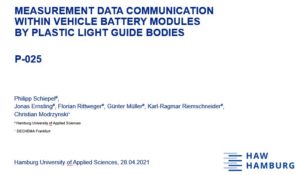Summary:
Traction batteries for electric vehicles are usually structured in modules of 10-36 cells. Currently these modules have been equipped with a monitoring electronic unit that collects measurement data from all cells and a limited number of other sensors. This module electronic unit communicates with a central battery management system.
Future concepts require more sensors per cell. This extension includes impedance measurement, temperature and pressure measurement, a reference electrode or a condition monitoring via ultrasound or optical observation. These extended concepts include one electronic unit per cell in the module. It can be implemented as a specialized chip or as a low-power microcontroller, short called cell controller. The cell controllers transmit data to a module controller, which connects to the battery management system.
The requirements for this communication channel include real-time behavior with short latency time, relatively low data rate, as well as mechanical robustness and cost-effective solutions. The different ground potential levels of operating voltages of the cell controllers are noticeable. Therefore, a galvanic separation of the communication is necessary. In addition, electromagnetic compatibility must be ensured. Favorite candidates are:
– wired serial connection with potential separation, as star, ring or bus structure
– communication with high-frequency signals via the existing electrical connection, as power line communication
– wireless radio communication at near range inside the module enclosure
– communication by optical components
For the latter, conventional fiber optic data communication with glass or plastic fibers and optical connectors is considered too costly in terms of components and assembly. For this reason, an approach was developed that requires less effort. This concept is based on a common light guide body, which can be produced very easily as a flat transparent plastic part of a few millimeters thickness. This light guide body connects the cells under the top cover of the module.
The digital signals of the cell and module controllers are fed into the light guide or coupled out of it by optoelectronic components. Suitable are optoelectronic transceivers (combined transmitter and receiver) which have been developed for free space communication according to the IrDA standard (Infrared Data Association). They support bidirectional data communication. A master-slave data protocol has been implemented for the optical communication channel. Construction solutions for the design of the light guide body are presented. A practical demonstration for a typical module is shown. Advantages for a later industrialization are a galvanic isolation, ensured electromagnetic compatibility and low-cost production and assembly without plugs, cables or optical fibers.
We are happy to forward your request / feedback.

